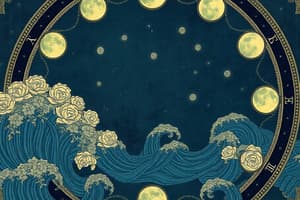Podcast
Questions and Answers
What are the different types of tides and when do they occur?
What are the different types of tides and when do they occur?
- Spring tides during full and new moon
- Neap tides during first and last quarter moon
- Both A and B (correct)
- None of the above
How do spring and neap tides occur?
How do spring and neap tides occur?
Spring tides occur when the moon, earth, and sun are in alignment, and neap tides occur when they form a right angle.
How often do high and low tides occur?
How often do high and low tides occur?
Twice daily
How is the moon's gravity able to create high and low tides?
How is the moon's gravity able to create high and low tides?
What is gravity?
What is gravity?
When is gravity stronger?
When is gravity stronger?
What happens during high tide?
What happens during high tide?
What happens during low tide?
What happens during low tide?
What causes the change of season?
What causes the change of season?
What causes the phases of the moon?
What causes the phases of the moon?
What happens during a total solar eclipse?
What happens during a total solar eclipse?
How long does earth take to orbit once around the sun?
How long does earth take to orbit once around the sun?
How long does earth take to rotate once on its axis?
How long does earth take to rotate once on its axis?
About how long does it take for the moon to orbit the earth?
About how long does it take for the moon to orbit the earth?
About how long does it take for the moon to rotate on its axis?
About how long does it take for the moon to rotate on its axis?
Why do we always see the same side of the moon?
Why do we always see the same side of the moon?
Why don't solar and lunar eclipses happen every month?
Why don't solar and lunar eclipses happen every month?
What direction does the north pole face in relation to the sun during winter?
What direction does the north pole face in relation to the sun during winter?
During the winter the sun's rays are?
During the winter the sun's rays are?
The earth's seasons are caused by the earth's?
The earth's seasons are caused by the earth's?
In January, the Earth is the?
In January, the Earth is the?
The northern and southern hemisphere have the same?
The northern and southern hemisphere have the same?
An ___ occurs on a day with 12 hours of daylight and 12 hours of darkness.
An ___ occurs on a day with 12 hours of daylight and 12 hours of darkness.
A __ eclipse happens when the earth is between the sun and the moon.
A __ eclipse happens when the earth is between the sun and the moon.
How many times each year do we have an equinox?
How many times each year do we have an equinox?
What types of gas is earth's atmosphere mostly made of?
What types of gas is earth's atmosphere mostly made of?
What causes day and night on earth?
What causes day and night on earth?
What is the planetary arrangement in order from smallest to largest?
What is the planetary arrangement in order from smallest to largest?
What are the gas giant planets?
What are the gas giant planets?
What are the terrestrial planets?
What are the terrestrial planets?
What is a retrograde rotation?
What is a retrograde rotation?
Flashcards are hidden until you start studying
Study Notes
Tides
- Spring Tides: Occur during full and new moons; extreme high and low tides when the sun, Earth, and moon are aligned.
- Neap Tides: Occur during first and last quarter moons; weak tides when the sun, moon, and Earth form a right angle.
- Tidal Frequency: High and low tides occur twice daily.
Gravity
- Definition: Force that exists between two or more objects.
- Strength Factors: Gravity is stronger with greater mass and closer distance between objects.
- Effect on Tides: Moon's gravitational pull creates bulges in ocean water, resulting in high tides.
Moon Phases and Eclipses
- Phases of the Moon: Caused by the changing positions of the moon, Earth, and sun.
- Total Solar Eclipse: Occurs when the sun, moon, and Earth are aligned, with the moon blocking sunlight, resulting in darkness.
- Lunar Eclipse: Happens when Earth is between the sun and the moon.
Earth's Rotation and Orbit
- Orbital Period: Earth takes one year to orbit the sun.
- Rotation Period: Earth rotates once on its axis in one day.
- Moon's Orbital Period: The moon orbits Earth approximately once a month.
- Same Side Visibility: We always see the same side of the moon because its rotation speed matches its orbit around Earth.
Seasonal Changes
- Causes of Seasons: Earth's tilted axis leads to seasonal changes.
- Sun's Rays: Slant during winter, causing less direct sunlight.
- Equinox: Occurs when there are 12 hours of daylight and darkness; happens twice a year.
- Regional Alignment: Northern and southern hemispheres experience opposite seasons.
Atmosphere and Composition
- Main Gas in Atmosphere: Nitrogen is the predominant gas in Earth’s atmosphere.
Planetary Classification
- Terrestrial Planets: Mercury, Venus, Earth, Mars; closest to the sun and Earth-like in composition.
- Gas Giants (Jovian Planets): Jupiter, Saturn, Uranus, Neptune; larger planets composed mainly of gas.
- Planetary Order: Arranged from smallest to largest: Mercury, Mars, Venus, Earth, Neptune, Uranus, Saturn, Jupiter.
Additional Concepts
- Retrograde Rotation: A clockwise rotation of a planet compared to its orbit.
- Earth's Position in January: Earth is farthest from the sun in January.
- Day/Night Cycle: Caused by Earth’s rotation on its axis.
- Eclipses Frequency: Solar and lunar eclipses do not happen every month due to the alignment requirements.
Studying That Suits You
Use AI to generate personalized quizzes and flashcards to suit your learning preferences.




